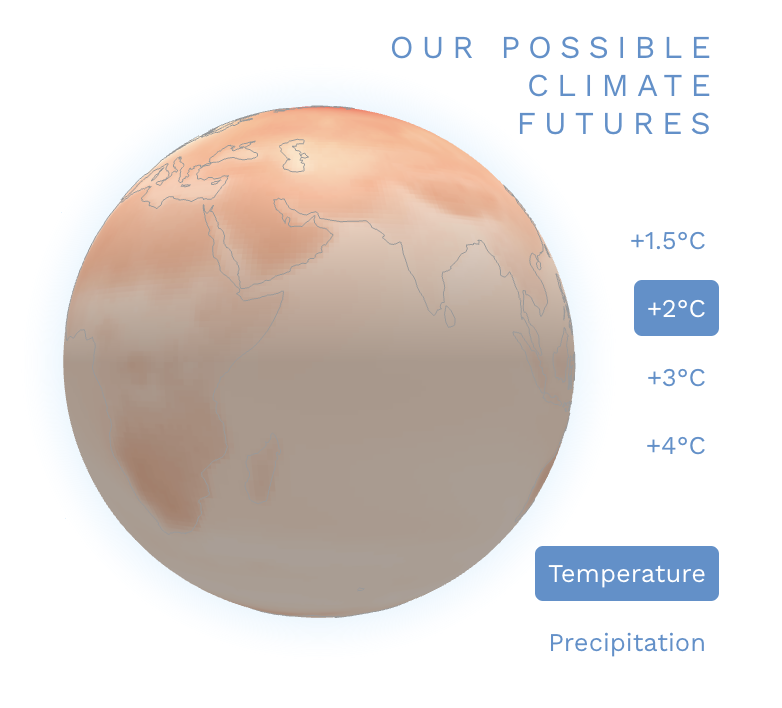IPCC WG1 Interactive Atlas

Introduction
A significant innovation in the Intergovernment Panel on Climate Change (IPCC) Sixth Assessment Report Working Group 1 (AR6 WG1) report is the inclusion of the Interactive Atlas, allowing flexible spatial and temporal analyses of much of the observed and projected climate change information underpinning the WGI assessment. The Interactive Atlas has two components:
- The first (regional information) includes the ability to generate global maps and a number of regionally aggregated products (time series, scatter plots, tables, climate stripes, etc.) for observed and projected climate change for time periods, emissions scenarios or global warming levels of interest. It integrates a range of different datasets, including global and regional observations and the three most recent coordinated global and regional climate projection experiments: CMIP5, CORDEX and CMIP6, for different key variables, extreme indices and climatic impact-drivers (CIDs).
- The second component (regional synthesis) provides qualitative information about changes in climatic impact-drivers (CIDs) in several categories such as heat and cold, wet and dry, or coastal and oceanic. Users can select one or several impact-drivers and visualize the regional historical trends and projected changes over the sub-continental reference regions.
Access the interactive atlas from the IPCC website.
This weADAPT article is an abridged version of text from the IPCC website. Please access the original website for documentation and access to regional information and synthesis. License and reproducibility details are also available.
Regional Information
TheInteractive Atlas regional information supports the assessment done in the AR6-WGIchapters, the Technical Summary (TS) and the Summary for Policymakers (SPM), allowing for flexible temporal and spatial analyses of trends and changes in key atmospheric and oceanic variables, extreme indices and climatic impact-drivers (CIDs), as obtained from several global and regional observational and model simulated datasets used in the report.
These analyses are available for a range of historical and future periods and emissions scenarios or warming levels.
In order to facilitate the use of this component of the interactive Atlas for users with different needs, it includes two alternative interfaces: simple (focusing on climate futures) and advanced. The simple interface is intended for the general public, media, teaching and decision makers, since it expands the information on climate future for different global warming levels presented in the SPM (in particular figure SPM.5). The advanced interface is more intended for researchers and practitioners.
Datasets
The Interactive Atlas provides information for both observations and model simulations, the former for the recent-past and the latter for paleoclimate, recent-past and future periods.
The Interactive Atlas also includes information on some illustrative socioeconomic forcing (population and anthropogenic missions, for different SSPs) used by the modeling community, particularly by CMIP6.
Visit the IPCC Interactive Atlas Regional Information tab to explore the regional information data and create your own climate maps.
Regional Synthesis
TheInteractive Atlas regional synthesis supports exploration of the data underpinning the regional information provided in theTechnical Summary and theSummary for Policymakers.
It provides synthesis information about changes in climatic impact-drivers (CIDs) in several categories such as heat and cold, wet and dry, snow and ice. Users can visualise information on observed trends and projected changes for individual CIDs in a map, table or graphic.
The information presented on regional observations is where there is evidence for increasing or decreasing trends and if there is additional evidence on attribution of these trends. The information presented on projected regional climate changes is where there is evidence for increases or decreases at either high, medium or low confidence.
The CID future changes summarized in the regional synthesis refer to a 20 to 30 year period centred around 2050 and/or consistent with 2°C global warming compared with a similar period within 1960-2014 or 1850-1900.
Head over to the IPCC Interactive Atlas Regional Synthesis tab to explore the different climate impact-drivers and how they have been affecting, and are projected to affect regions around the world.
Watch this short video for an overview of the Interactive Atlas and descriptions of its main components and functionalities. Click here to see further user guidance.
Suggested Citation:
Gutiérrez, J.M., R.G. Jones, G.T. Narisma, L.M. Alves, M. Amjad, I.V. Gorodetskaya, M. Grose, N.A.B. Klutse, S. Krakovska, J. Li, D. Martínez-Castro, L.O. Mearns, S.H. Mernild, T. Ngo-Duc, B. van den Hurk, and J.-H. Yoon, 2021: Atlas. In Climate Change 2021: The Physical Science Basis. Contribution of Working Group I to the Sixth Assessment Report of the Intergovernmental Panel on Climate Change [Masson-Delmotte, V., P. Zhai, A. Pirani, S.L. Connors, C. Péan, S. Berger, N. Caud, Y. Chen, L.Goldfarb, M.I. Gomis, M. Huang, K. Leitzell, E. Lonnoy, J.B.R. Matthews, T.K.Maycock, T. Waterfield, O. Yelekçi, R. Yu, and B. Zhou (eds.)]. Cambridge University Press. In Press. Interactive Atlas available from Available fromhttp://interactive-atlas.ipcc.ch/
Related resources
- The IPCC's 6th Assessment Report: Impacts, Adaptation, and Vulnerability - Summary for Policymakers
- ZEROing IN on this critical decade for climate: Insights from the latest IPCC reports on the Paris Agreement, 1.5°C, and climate
- Mapping the Evolution and Current Trends in Climate Change Adaptation Science
- Climate Models: What They Show Us and How They Can Be Used in Planning
- The IPCC's 6th Assessment Report Climate Change 2021: The Physical Science Basis
(0) Comments
There is no content